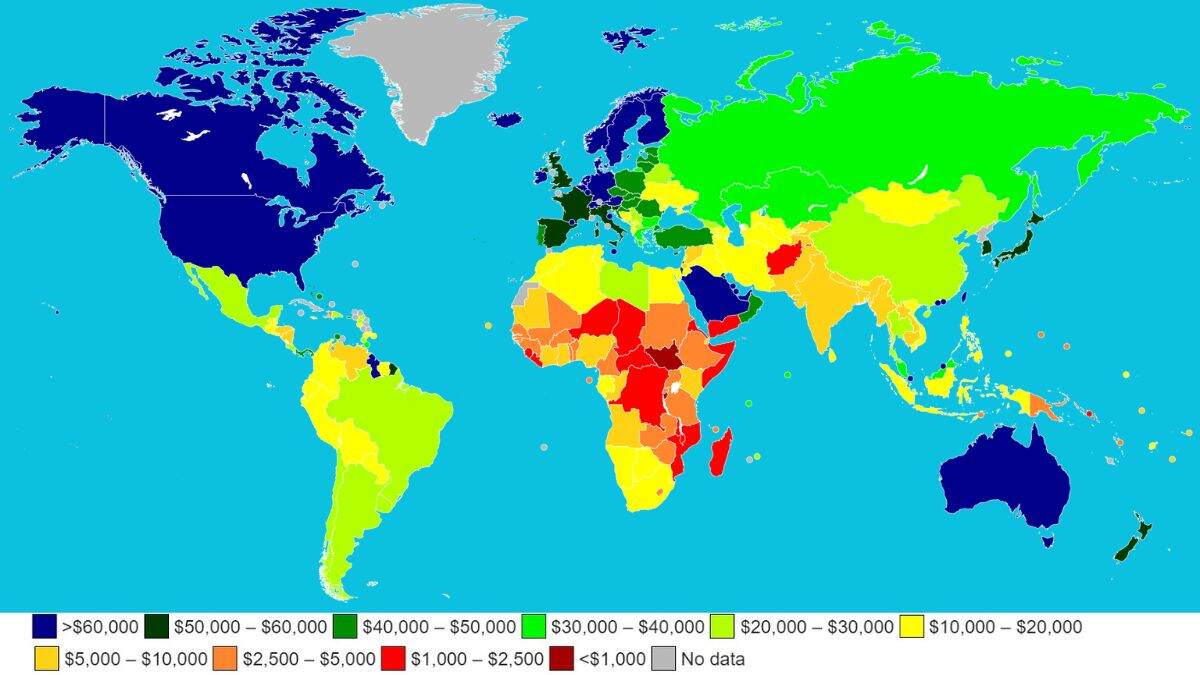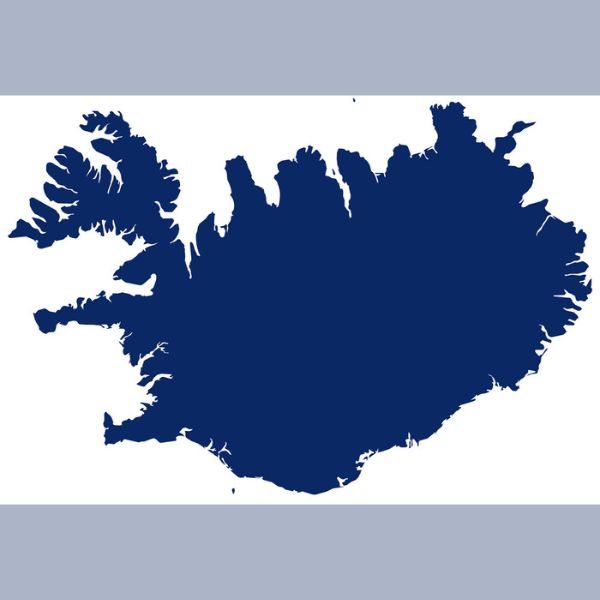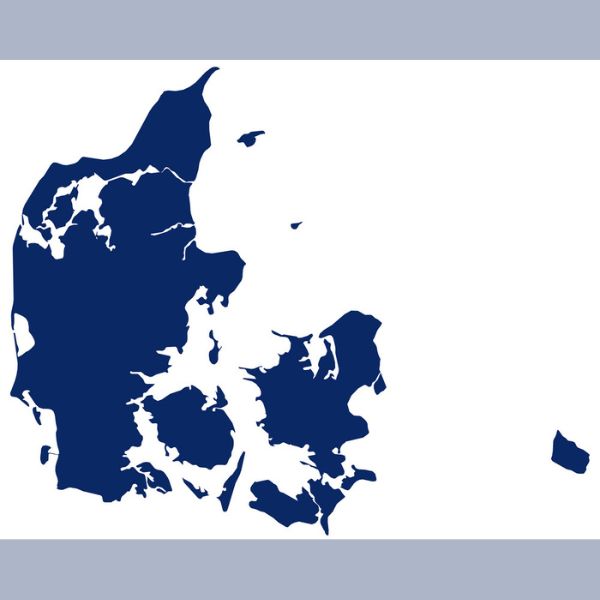When evaluating the economic prosperity of nations and their citizens globally, the metric often at the forefront is Gross Domestic Product (GDP) by country. However, it's important to recognise that GDP represents the aggregate monetary value of all goods and services produced within a nation's borders within a specified timeframe, typically annually or quarterly.
In contrast, GDP per capita provides a more nuanced perspective as it factors in the population size. This metric offers insight into the average wealth and income levels within a country, facilitating comparisons of living standards across different nations.

When both population size and economic output are considered, we arrive at a key indicator known as Purchasing Power Parity (PPP). While PPP provides valuable insights, it's worth noting that it may not offer absolute statistics for precisely ranking the wealthiest and poorest countries. For example, some affluent nations may function as tax havens, artificially inflating their GDPs with wealth generated externally. Nevertheless, the GDP per capita ranking for 2023, adjusted for PPP, brings us closer to comprehending the economic wealth held by diverse nations on the global stage.
In 2024, Luxembourg is the world's wealthiest nation by GDP per capita. With an impressive GDP per capita of $140,312, Luxembourg stands out as a beacon of economic prosperity on the global stage.
ALSO READ| List of Top 10 Countries With Highest GDP in 2024
10 Countries By GDP Per Capita (PPP)
As per the International Monetary Fund (IMF), the global growth forecast for 2024 is anticipated to maintain stability at 3.1%, reflecting a modest 0.2% improvement from the projections made in October. Subsequently, global growth is poised to escalate to 3.2% in 2025. Notably, the IMF anticipates a deceleration in growth within the United States, attributed to the continued implementation of stringent monetary policies.
| Country | Continent | GDP-PPP per capita (in USD) |
| Luxembourg | Europe | 140,312 |
| Ireland | Europe | 117,988 |
| Switzerland | Europe | 110,251 |
| Norway | Europe | 102,465 |
| Singapore | Asia | 91,733 |
| Iceland | Europe | 87,875 |
| Qatar | Asia | 84,906 |
| United States | North America | 83,066 |
| Denmark | Europe | 72,940 |
| Macao SAR | Asia | 70,135 |
Countries By GDP Per Capita (PPP)
Luxembourg
GDP: $89.1 billion
Population: 639 thousand

Luxembourg emerges as a standout among European nations, having navigated the challenges of the Covid-19 pandemic with resilience. Renowned for its strategic allocation of resources, Luxembourg has leveraged its wealth to uphold exemplary standards of living, healthcare, and education for its populace. Additionally, the country holds the distinction as a premier global tourist destination, boasting enchanting castles, verdant landscapes, and charming canals that captivate visitors from around the world.
Ireland
GDP: $589.57 billion
Population: 5.03 million

Following the seismic impact of the 2008 financial crisis, Ireland embarked on a determined path of revitalisation, particularly focusing on restructuring its banking sector. Implementing rigorous measures, including reductions in public-sector wages, Ireland orchestrated a remarkable economic turnaround that has positioned it favourably today. Notably, Ireland has ascended as one of the globe's foremost corporate tax havens, attracting multinational giants like Apple, Google, and Microsoft. Their substantial contributions have significantly bolstered the Irish economy, with these companies collectively contributing over 50% to its recent economic growth.
Switzerland
GDP: $813 billion
Population: 8.70 million

Switzerland stands as a premier global tourist destination, renowned for its breathtaking landscapes and vibrant cultural heritage. Moreover, the nation boasts a thriving financial sector, adding another layer of economic vitality. Benefiting from a diverse export portfolio, including precious metals, precision instruments, and cutting-edge machineries like computers and medical devices, Switzerland sustains a robust economic foundation.
Remarkably, approximately 74% of Switzerland's GDP emanates from the services sector, underscoring its significance in driving economic growth. Meanwhile, the industrial sector contributes 25%, while the agricultural sector makes up less than one% of the national GDP. Notably, Switzerland distinguishes itself with the lowest Value Added Tax (VAT) rate in Europe, further enhancing its appeal as an economic hub and fostering a conducive environment for business and investment.
ALSO READ| Top 10 World’s Largest Economies [Updated 2024]
Norway
GDP: $546.77 billion
Population: 5.41 million

Norway reaffirms its status as a leading petroleum provider within Western Europe. Despite the economic downturn experienced during the COVID-19 crisis, the nation has demonstrated commendable resilience, achieving significant financial recovery. Notably, Norway's prudent financial management is exemplified by its possession of a $1.3 trillion sovereign wealth fund, the largest of its kind globally. This formidable resource not only fortifies the country's financial stability but also equips it to effectively address any emergent crises with agility and foresight.
Singapore
GDP: $497.35 billion
Population: 5.45 million

Singapore stands as a global powerhouse, renowned for its robust business ecosystem and bustling trading centres. With a considerable presence of high-net-worth individuals, the nation epitomises economic dynamism and prosperity. However, in recent years, Singapore's economy has faced successive challenges, initially stemming from the impacts of the pandemic and subsequently exacerbated by the slowdown in the Chinese economy.
China, a pivotal trading partner for Singapore, particularly in its manufacturing sector, accounts for a significant portion of the nation's GDP, approximately 21.6%. The confluence of these factors underscores the resilience of Singapore's economy while highlighting the importance of adaptability and strategic foresight in navigating global economic fluctuations.
Iceland
GDP: $30.57 billion
Population: 373 thousand

Iceland's economy revolves around key sectors including tourism, fishing, and aluminium exports. While presently recuperating from the impact of the pandemic, tourism played a significant role, contributing 8.1% to the GDP and accounting for 35% of the country's goods and service export revenue in the pre-COVID era. Additionally, exports of aluminium and marine products constituted substantial portions of Iceland's total exports, comprising approximately 40% and 34% respectively. These sectors collectively underscore the diverse economic landscape of Iceland, emphasising the importance of both traditional industries and emerging sectors in driving its economic growth and resilience.
ALSO READ| List of Top 10 Economies in 2023- Know the Fastest Growing Economies in the World
Qatar
GDP: $235.5 billion
Population: 2.93 million

Qatar, alongside the UAE, secures its position among the top 10 economies by GDP per capita for 2023, primarily owing to its abundant reserves of natural resources. Qatar, in particular, boasts vast reserves of oil and natural gas, far surpassing its population size. This abundance of natural resources serves as a cornerstone of its economic prosperity, propelling Qatar to a prominent position among the world's wealthiest nations.
United States
GDP: $26.95 trillion
Population: 332 million

United States secures its place among the top 10 economies by GDP per capita PPP, albeit at a relatively lower rank within the list. Despite its positioning, the United States remains a dominant economic force globally, leveraging its vast resources and innovative prowess to sustain its economic might. Additionally, the nation's formidable military capabilities further reinforce its influence and power on the world stage, contributing to its multifaceted identity as a global powerhouse.
Denmark
GDP: $420.8 billion
Population: 5.86 million

Denmark emerges as a beacon of safety and quality of life on the global stage, holding the prestigious second position in the Global Peace Index and ranking fourth in the world for standard of living according to Numbeo's Quality of Life Index. Demonstrating remarkable self-sufficiency, Denmark relies on its energy resources and exports to European nations, bolstering its economic resilience and stability.
While services constitute a significant portion, accounting for 67% of its GDP, Denmark also excels in the production of pharmaceutical products, industrial machinery, and electrical machinery. This diversified industrial landscape underscores Denmark's ingenuity and innovation, solidifying its reputation as a dynamic economic player with a commitment to excellence.
Macao SAR
GDP: $22 billion
Population: 695,168
As a special administrative region under China's jurisdiction, Macao SAR's prosperity predominantly stems from its thriving casino industry, boasting over 40 establishments that attract visitors from across the globe. Despite facing significant challenges during the COVID-19 crisis, including stringent travel restrictions and frequent lockdowns, Macao's economy is swiftly rebounding, indicative of its resilience and adaptability.
The region's robust recovery trajectory underscores its enduring appeal as a premier travel destination and entertainment hub. With tourism playing a pivotal role in its economic resurgence, Macao SAR is poised to continue its trajectory towards rapid economic revitalisation, showcasing its capacity to overcome adversity and thrive in a dynamic global landscape.
Note: The list is based on data from the IMF’s database as of February 2024.
ALSO READ| List of Top 10 Poorest Countries In Africa 2024 as per GNI and GDP Report
ALSO READ| Differences between GDP and GNP
ALSO READ| What is the difference between Real GDP and Nominal GDP?
Comments
All Comments (0)
Join the conversation